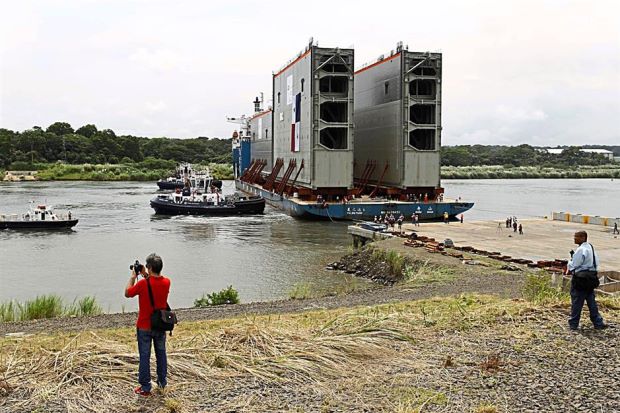Greg Lindsay at the World Economic Forum reports about the Canal expansion.
Look ahead interviews the leading authorities on trends, challenges and opportunities in technology and innovation. This week’s Q&A is with Adie Tomer, a senior research associate and associate fellow at the Brookings Institution Metropolitan Policy Program. Mr Tomer describes how the imminent expansion of the Panama Canal will reshape local shipping lanes and global economic geography.
What does the Panama Canal’s expansion and a new generation of “post-Panamax” ships mean for the economics of shipping?
As the newest Panama Canal expansion reaches completion, interest from logistics and trade professionals has reached a fever pitch. The over $5bn project will boost ship capacity upwards of 50%. With the largest ships now carrying up to 13,000 shipping containers, larger volumes of electronics, T-shirts, grains and other commodities promise to bring Eastern and Western Hemisphere markets closer together.
However, there are legitimate questions over how much these shipping economies will affect spatial economies: the “where” of goods supply and demand. Combined with other global economic forces like higher labour costs in Asia, a rising middle class across emerging countries and dropping energy prices in North America, logistics costs related to the Canal’s new capacity is only one of many forces affecting the trade levels between markets.
Which US cities will be the big winners and losers in a post-Panamax world as infrastructure requirements change?
Along the US Atlantic Coast, there is a veritable arms race between ports to dredge their harbors, roll out new cranes and obtain a bigger slice of American logistics business. Ports from Miami to Boston are making major bets—often involving upwards of a billion dollars—that they’ll be winners in the new Panamax world. Yet, in the short run, the American logistics pie is only set to grow in a similar range as macroeconomic growth—at rates around 2% or 3%. That means a major winner in one market likely will mean relative losses in others. Meanwhile, the Pacific ports and their naturally deep harbours still loom as the preferred shipping spot for most Asian goods, and any investments in the North American land bridge only strengthen their position.
Beyond the US, who will be most affected by a post-Panamax world? What does it mean for Brazilian commodity exports to China, for example?
While the US attracts most of the post-Panamax attention due to its global economic status, the entire Western Hemisphere will be affected by the new Canal capacity. Ships carrying more bulk products will make Latin American commodities more attractive to fast-growing Asian markets. This is especially true for metals, agriculture and other raw goods that are key initial ingredients in ever-longer global value chains. Trade is also predicted to grow within the hemisphere, creating a thicker “X” of crisscrossing trade lanes between the Atlantic and Pacific coasts. The rise of Latin American middle classes is especially important in this regard, as they become larger markets for advanced manufacturing products departing from US and Canadian metro areas.
What are the biggest threats to the Canal’s dominance of the Western Hemisphere?
The newest Panama Canal expansion is a generational investment—and, as a consequence, it will take a generation to see the full effects on markets across the globe. Yet, in that kind of time frame, we should expect the unexpected. As it stands, the Canal is responsible for moving only 6% of world trade. As a consequence, the Canal is only one of many global economic forces that will create Darwinian adaptations among metropolitan economies and their trade networks. On the logistics side alone, Canada’s land bridge investments and a potential Nicaraguan canal will continue to drive down freight prices and force continued Canal-related innovations, especially in terms of landside warehousing. On the production side, disruptive technologies like enhanced robotics may shift ocean-crossing trade to intra-continental trade.
The Canal will continue to be a major presence in global trade and investment, but competition for trade-related business will be fierce.
